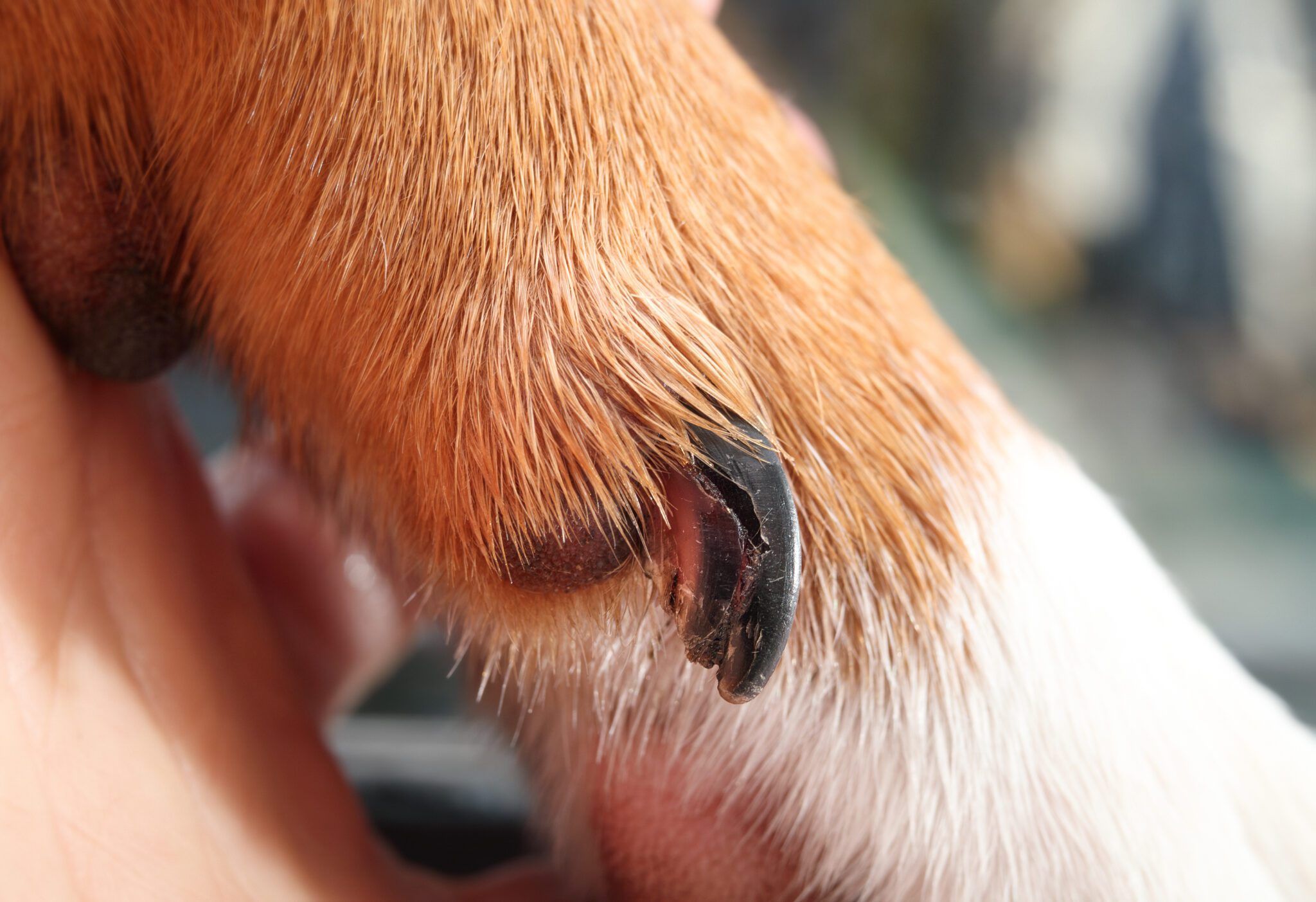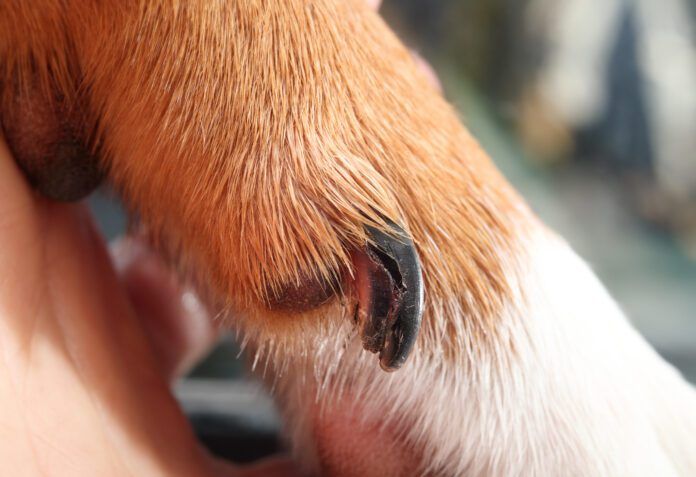The most common problem for dog claws is lack of proper trimming, but it is possible to have truly unhealthy dog nails. Signs that your dog needs a veterinary visit include brittle nails that break frequently, discharge at the base of the nail, and claws growing into the paw pads.
Healthy vs. Unhealthy Dog Nails
Your dog’s claws should be short and strong with a smooth, slightly shiny surface. Ideally, they will have a gentle downward curve, tapering toward the point.
For dogs with white nails, a healthy nail will be the same color as human nails – pale pinkish at the base where the claw wraps around the sensitive quick and milky white at the end where it is just solid keratin.
For dogs with black nails, the claw will be a uniform black color.
Dog nails can also be varying shades of reddish brown depending on the pigmentation of your dog’s skin. These claws typically are lighter at the tip, but the difference may be more subtle than with white nails.
Each claw should be growing smoothly out of the dog’s paw as an extension of the toe. Many nails have a shallow groove along the bottom, which is normal.
Signs of unhealthy dog nails include:
- Frequent broken nails
- Brittle texture that cracks or breaks frequently or shatters during nail trims
- Split nails
- Soft, mealy texture
- Rough or uneven surface
- Pus oozing from nail, including when cut
- Bleeding around the base of the claw
- Oily discharge on or at the base of the nail
- Color change
- Some nails being a dramatically different shape than others
- Changes in growth rate or direction
- Licking and chewing at the nails and paws
Common Dog Nail Problems
These are some of the more common causes of unhealthy dog nails:
- Bacterial nail infection
- Fungal nail infection
- Broken nails due to trauma
- Broken or split nails due to excess length
- Malnutrition
- Allergies
A less common but more severe potential cause of nail problems is the autoimmune disorder lupoid onychodystrophy (also called symmetrical lupoid onychodystrophy or SLO).
Fungal or Bacterial Nail Infection
Dog nails are pretty hardy, but they can become infected. These infections are usually secondary to other issues such as a cut, broken nail, or allergies that weaken the body’s defenses and allow infectious agents to set up shop.
The appearance of a nail infection can vary. Bacterial nail infections generally have an oily or pus-like discharge, while fungal infections such as ringworm may be crusty. Yeast infections often have an odor similar to corn chips.
Your veterinarian will use a skin scrape and cytology to evaluate the infectious agent. Treatment may include both topical medications right at the source as well as oral medications for deep or widespread infections.
It is critical to treat for the full course of medication and to keep any follow up appointments. Nail bed infections can be stubborn and the outside may look perfectly normal while there is still infection present deeper in the claw base.
Broken Nails
Dogs can catch and break a nail on fences, furniture, their crates, or even running in the woods. The break may just affect the tip of the claw or could go all the way to the base. Sometimes the toe may be broken or dislocated as well.
The longer the nail, the greater the risk of a break. Long nails can get caught on clothing and dog beds or break during normal activity due to their excess length. Loose dewclaws that do not stay close to the leg are also at higher risk of getting caught on things when the dog is running around.
If a piece of the broken part of the nail is still attached, it should be removed. Loose, flapping nail tissue is just going to keep getting caught on things and causing your dog more discomfort. You may be able to remove the loose piece on your own, but a vet visit is often needed.
Remember that your dog’s paw may be quite painful and even the sweetest dog may bite when in pain. Cleaning and treating the broken nail may require sedation.
Your veterinarian may prescribe antibiotics to prevent infection and may recommend bandaging the paw for a few days if the nerve within the claw is exposed. Pain meds may also be prescribed.
Allergies
If your dog suffers from chronic nail infections or has issues with multiple claws/paws at the same time, an underlying allergy may be part of the problem. Your dog may be allergic to something in his food or in the environment, or to multiple things. Getting the allergies under control will help to prevent recurring nail infections.
Lupoid Onychodystrophy
Lupoid onychodystrophy or SLO is not common, but it is very unpleasant. This autoimmune disorder causes your dog’s immune system to attack the nails. It can cause the claws to be brittle or abnormally shaped, and to completely fall off. It can also be quite painful.
If your dog frequently breaks or loses nails, especially if multiple nails are often affected at the same time, lupoid onychodystrophy may be the culprit. Abnormal nail texture that persists even with proper nutrition is also a cause for concern.
German Shepherd Dogs, Rottweilers, and Gordon Setters are at increased risk of having this issue.
Diagnosing SLO requires ruling out other issues and taking a biopsy of the nail bed. It is then treated with immunosuppressive medications.
Monitoring Your Dog’s Nails
Ideally, you should be trimming your dog’s nails at least every other week to keep them at a proper length. Frequent nail trims mean you can still make progress and maintain short nails without having to cut a bunch of nail off each time.
Having regular nail trims as part of your care and grooming routine also provides the perfect opportunity to observe your dog’s nails close up. You will get a good sense of what your dog’s claws normally look like and how fast they grow. This allows you to spot any concerning changes early.
When to Call Your Vet
Some minor nail issues will resolve with time and proper nail trimming to shape the claws, but others require a veterinary exam and medications to get your pup up to snuff.
Schedule an appointment with your dog’s vet if:
- Your dog is in pain due to a broken nail
- Claws are curling around and growing into the paw pad
- There is an abnormal odor from the paws
- A nail has split
- Your dog frequently breaks or rips off nails
- Your dog bites at his nails—this is due to itchiness or discomfort
- There is bleeding or discharge around the base of the claw
- Claws ooze pus or discharge when cut
- The texture or color of the nails has changed
- Claws are growing in unusual directions
- A broken nail does not grow back
Thankfully, most claw issues are not an emergency and can wait for regular business hours to be addressed. The exception is if you are unable to stop bleeding from a broken nail even after applying pressure.
If you have a new dog who may not have had proper care and nutrition before joining your family, don’t worry too much about unusual nail texture, shape, or color. Poor nutrition and hazardous living conditions can lead to unhealthy dog nails, and it may take a couple months before your dog produces normal, healthy claws. Feed a complete and balanced diet, trim the nails regularly, and monitor their progress over time. But if your new dog’s paws and claws are painful, smell bad, or have a discharge, he will need to be checked over by a veterinarian.

